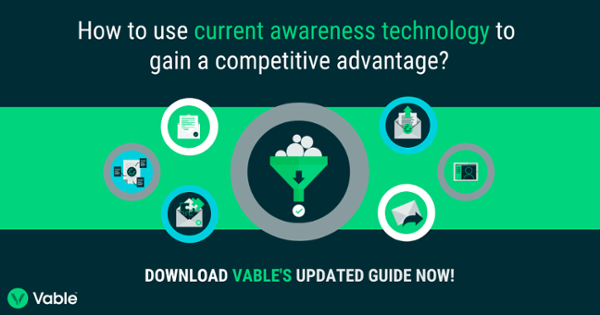Share this
Competitive advantage: How can we optimise our competitive intelligence techniques?
May 23, 2018

As information professionals, we play important roles in our organizations’ competitive intelligence programs but often neglect to apply that same rigour to our own information environments. Just like others in our organizations, librarians must understand precisely who their competition is, the library “owned” products and services provided to a client base, the words and mechanisms employed to persuade prospective clients, the degree of product/service satisfaction, and most importantly, the value your clients place on each.
Know your Information Environment
Appreciating the strength of producer-consumer relationships (and what it would take to break those bonds) is one of the responsibilities library staff assumes as it puts on its competitive intelligence (CI) hat. How loyal is each client and what could convince a target customer to explore what the library has to offer today? The goal is continuous improvement of the library’s product line and the development and delivery of targeted, customized, and personalized services to its user community.
The competitive intelligence cycle begins with a scan of the environment that is wide enough to catch the beginnings of any trend, and efficient enough to track the trend as it gains traction. At the same time, libraries need to identify their competition, both within and outside the organization, implementing an efficient mechanism to monitor what those entities are doing and how they are approaching the same target market with products and services.
Which Analytic Framework is Right for You?
Applying a series of analytic frameworks will give the organization a clear picture of how others may impinge on the library’s domain. The following frameworks can assist in developing an effective CI program for any library. They were chosen for their broad utility, ease of implementation, and the fact that each is structured to indicate a path forward.
PESTLE Analysis
PESTLE Analysis is a strategic framework for understanding macro-environmental variables that affect strategic planning: Political, Economic, Social, Technological, Legal, and Environmental. For each factor, describe 3-6 ways in which change is likely to occur in the near-term. It is helpful to indicate the likely impact of each environmental dynamic (high, medium, or low) so effective strategies can be developed for those variables that will significantly affect your organization’s ability to perform.
Driving Forces Analysis
Driving Forces Analysis can help to determine factors motivating adoption of a library’s products/services, as well as value drivers for customers, and factors preventing or restraining expanded adoption (or switching products). Forces that might accelerate adoption, including the application of advanced technology, can often be identified by conducting Driving Forces. Once you have identified the relevant driving forces, indicate which are likely to have the greatest impact on your community; these should be monitored for signals of change.
How Five Forces Shape Strategy
Five Forces is an industry analysis developed by Professor Michael Porter of Harvard University. Porter’s framework models an industry as it is influenced by five forces: Rivalry among existing organizations; potential entrants and barriers to entry; substitute and complementary products; bargaining power of clients/customers; and bargaining power of suppliers. For example, libraries should note:
- How publishers and database aggregators are approaching clients directly, bypassing the library
- What new technologies (e.g., machine learning, natural language processing) are being deployed, and how these are enabling your organization’s IT department to offer a broader range of services, potentially encroaching on your space.
This analysis can help determine the relative position of each information organization, differentiation factors, and competitive advantage.
SWOT Analysis
SWOT describes the alignment or “fit” between an organization’s internal capabilities (Strengths and Weaknesses) and Opportunities and Threats in the external environment. Two variants of the SWOT can be helpful to employ: Relative SWOT compares the firm’s strengths and weaknesses relative to those of the immediate competitors; TOWS suggests strategies that use your organization’s strengths to take advantage of opportunities (by overcoming weaknesses) and help use your strengths to avoid threats (or minimize weaknesses).
These are just a few of the ways in which CI can be used to the library’s advantage. Others to explore might include Scenario Analysis, Four Corners, Benchmarking, and Best Practices. However, don’t use any of these techniques if you are not going to follow through by changing the products/services offered or the process by which they are put together.
Which analytic technique will you choose to begin your library’s CI program? Don't forget to check out more Technology Solutions for Information Professionals!
Share this
- December 2025 (2)
- November 2025 (2)
- October 2025 (3)
- September 2025 (2)
- August 2025 (2)
- July 2025 (4)
- June 2025 (3)
- May 2025 (2)
- April 2025 (1)
- March 2025 (1)
- October 2024 (1)
- July 2024 (1)
- June 2024 (2)
- May 2024 (2)
- April 2024 (3)
- March 2024 (3)
- February 2024 (4)
- January 2024 (2)
- December 2023 (1)
- November 2023 (2)
- October 2023 (2)
- September 2023 (1)
- August 2023 (3)
- July 2023 (5)
- June 2023 (2)
- May 2023 (2)
- April 2023 (4)
- March 2023 (1)
- February 2023 (1)
- January 2023 (2)
- November 2022 (2)
- September 2022 (2)
- August 2022 (2)
- July 2022 (1)
- June 2022 (1)
- May 2022 (2)
- April 2022 (3)
- March 2022 (1)
- February 2022 (2)
- December 2021 (2)
- November 2021 (2)
- October 2021 (2)
- September 2021 (2)
- August 2021 (2)
- July 2021 (2)
- June 2021 (2)
- May 2021 (1)
- April 2021 (2)
- March 2021 (1)
- February 2021 (3)
- January 2021 (2)
- November 2020 (3)
- October 2020 (1)
- August 2020 (2)
- July 2020 (4)
- June 2020 (1)
- May 2020 (1)
- April 2020 (2)
- March 2020 (2)
- February 2020 (3)
- January 2020 (1)
- December 2019 (2)
- November 2019 (1)
- October 2019 (1)
- September 2019 (1)
- August 2019 (3)
- July 2019 (3)
- June 2019 (3)
- May 2019 (2)
- April 2019 (1)
- March 2019 (2)
- February 2019 (3)
- January 2019 (3)
- December 2018 (1)
- November 2018 (2)
- October 2018 (2)
- September 2018 (1)
- August 2018 (2)
- July 2018 (1)
- June 2018 (2)
- May 2018 (3)
- April 2018 (3)
- March 2018 (1)
- February 2018 (3)
- January 2018 (1)
- November 2017 (1)
- October 2017 (1)
- July 2017 (1)
- April 2017 (2)
- March 2017 (3)
- February 2017 (1)
- January 2017 (1)
- November 2016 (2)
- October 2016 (1)
- September 2016 (1)
- August 2016 (2)
- June 2016 (1)
- May 2016 (1)
- April 2016 (1)

